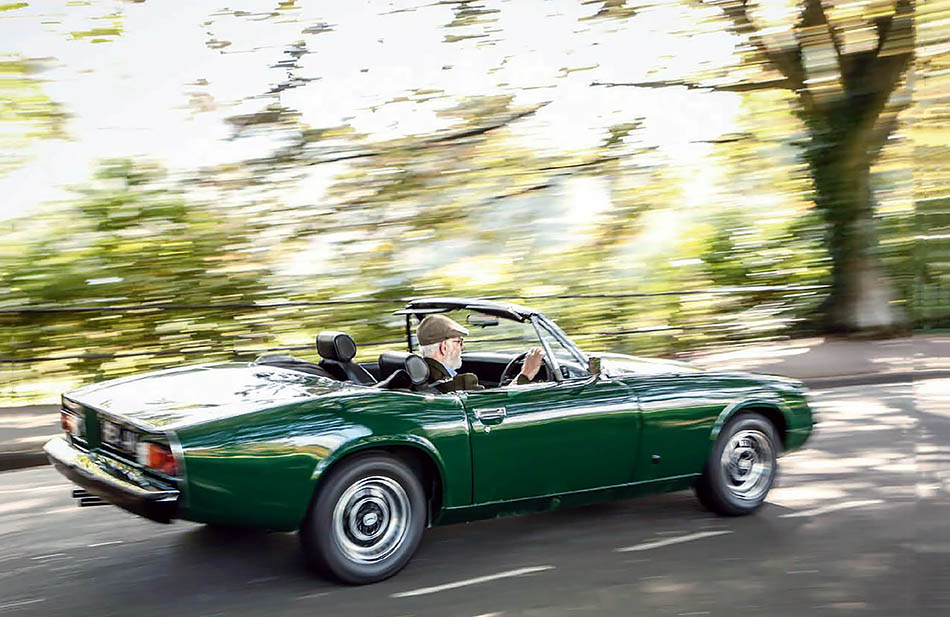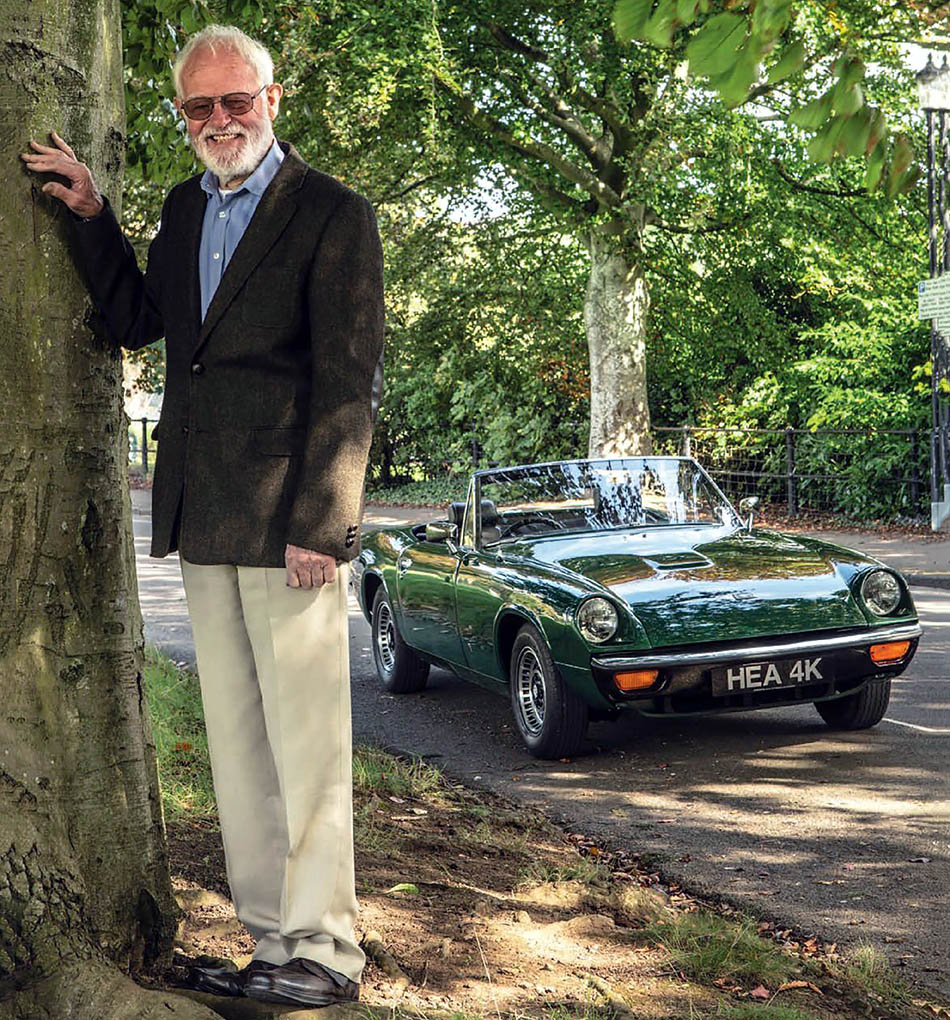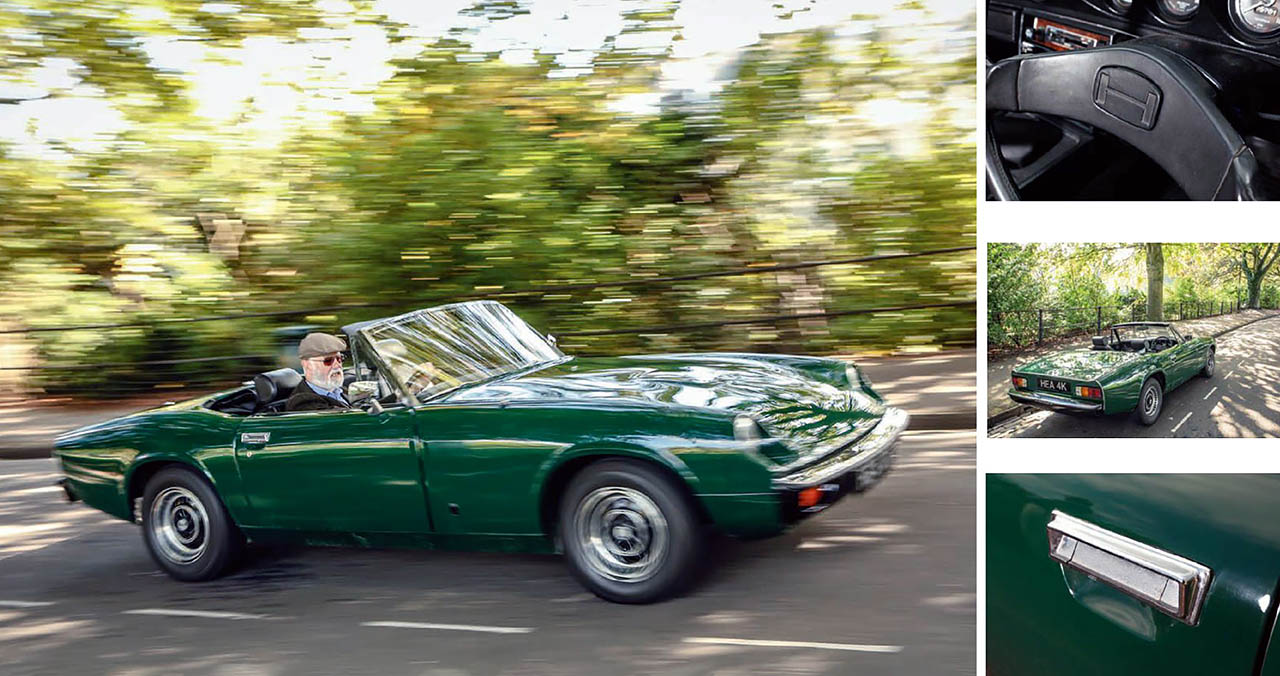
Jensen-Healey restored. Plus an insider’s view on the firm. History re-made. Fresh out of a lengthy restoration, this Jensen-Healey is a significant car in the latter-day saga of its maker. And, as an ex-Jensen employee, owner Tony Marshall has a tale or two to tell. Jon Pressnell hears them. Photography Tony Baker/Keith Anderson.

Marshall often had use of HEA 4K when he was sales manager at Jensen. Right, from top: on Autocar’s front cover, 31 August 1972; earlier proposal with TR6-like front end; now perfectly restored.
It was a nightmare rebuild. Spread over 10 years, it cost far more than such a car would normally be worth. It involved sundry disasters along the way, but for owner Tony Marshall those were a price worth paying because HEA 4K is not just any Jensen-Healey. It is a part of Jensen’s history, a latterly gory industrial drama in which Marshall himself played a minor role.
The registration number might give the game away, if you recall the Jensen-Healey’s launchtime road tests. For HEA 4K was the first J-H press car, a pre-production model built in April 1972 that was recycled as the fourth production vehicle by the financially straitened company. Most notably it was the subject of the memorably enthusiastic Autocar test of August 1972, in which the Healey was pronounced a future classic – a verdict that came to haunt the magazine when it had a signally wretched time running an early example as a long-termer.
Marshall lived all this, having joined Jensen in 1967 and having at times used HEA 4K as his personal transport during his period as sales manager. In seven years he witnessed the highs and lows of a firm whose fate was ultimately sealed by the catastrophe of making the Healey.
“When I joined, in July 1967, the last 700 left-hand- drive Austin-Healey 3000s were going down the line,” recalls Marshall. “It was a lovely firm, and still really a family business. Everybody knew everybody else.” But those days were changing. Industrial holding company Norcros, owner of Jensen since 1959, could see that its finances were rocky and would only get worse with the end of subcontract work making trimmed Big Healey bodies and building the Sunbeam Tiger. As a prelude to a planned disposal of the company, it brought in management consultancy Booz Allen Hamilton. The result was a thick report, the appointment as managing director of colourful monocled American Carl Duerr, and the ultimate sale of the business to investment bank William Brandt.
“Duerr was a breath of fresh air,” enthuses Marshall. “Jensen had been a bit hidebound under its British management – I didn’t meet the previous MD for weeks after I’d joined the firm. But every day Carl was first in, with the blokes – or ahead of them – and every day he was down the production line. This was a moment when we needed something like that. It was whizz-bang: straight in, spot all the problems. He was into everything in great detail, and always attempting to improve things. Kevin Beattie, the chief engineer, was one of the nicest people you could ever meet, but you can’t have companies led by engineers – you need salesmen. It must have been very difficult to have the MD telling him what to do, but there’s no doubt that Duerr was extremely welcome. He established a rapport with the shop floor. Morale went up. He got the company going, increased production, and improved quality. He was a PR man’s godsend. Everybody wanted to talk about Jensen. Good Relations had the best job in the world, doing PR for Jensen.”
But the flamboyant Duerr’s reign was cut short by Brandt selling the business to Californian car importer Kjell Qvale, whose first move was to initiate the Jensen-Healey project. “Qvale was a totally different character from Duerr – quiet, reserved, although a fantastic salesman,” says Marshall. “But he had some difficulty in running the company, particularly from a distance and in the light of the eventual union problems.”
The tortured history of the Jensen-Healey’s styling evolution and of the quest for a suitable engine is well known. Marshall recalls the second prototype, with its TR6-like looks, before William Towns was called in to give it a more aerodynamically sound front end. He also remembers Jensen borrowing a 2002tii from a local dealer one weekend, and its engine being hastily installed in the car. The BMW single-ohc ‘four’ was one of the power units under consideration in place of the Vauxhall motor originally used: “BMW said that, at the numbers we were talking, it wasn’t prepared to build engines for us – although it would have been happy if it had just been a question of supplying a few engines.”
The Healey was ultimately laid low by devastating build-quality and reliability issues, largely centred around the Lotus power unit, and then by the fatal blow of the 1973 oil crisis. But there was something more fundamental at play, according to Marshall. He recalls last-minute development mileage being run up by celebrated MGB racer Bill Nicholson, on all-night motorway stints ahead of the launch: “The trouble was that the Healey had to go down the line in ’72 for reasons of cashflow. We needed to pay the bills.” The car was simply not production-ready, he says – and Hethel was unable to provide the engines needed, once manufacture had started.
“Lotus was holding us up for ages and ages, making promises that it was going to make engines, but not delivering. Late in 1972 we were expecting 120 cars per week from Production, and, with luck, we were getting 50-60 engines. In the meantime 120 sets of wheels, gearboxes and so on were coming into the factory every week. The stocktaking area was absolutely stuffed with J-H parts. The tap couldn’t be turned off.
“It wasn’t the things going wrong with the Healey so much as the things going wrong with the company. It was going bust. It was staring us in the face. The oil crisis had meant that big V8 cars such as the Interceptor weren’t politically correct. By the time the MkII Jensen-Healey arrived it was too late – there was no money left.”
Introduced in August ’73, the MkII did indeed address many of the faults, including lacklustre presentation and limited choice of colours.
“We borrowed all sorts of vehicles from dealers – Fiats, Reliants and so on – and lined them up with the Healey,” recalls Marshall. “We had to get the car looking better, put some sparkle in it, add a bit of trim here and there, make a better job of the dash. And we did: the MkII looked a lot more attractive. I had the first metallic car just before I left in ’74. What a difference it made!”
Having quit Jensen before it finally entered receivership in 1975, Marshall eventually left the motor industry. In his retirement he bought a 541S and became an active member of the Jensen Owners’ Club: “In an unguarded moment I said that if ever HEA 4K came up for sale, I’d buy it. It was known to have survived, and eventually in 2005 it turned up on eBay, with a reserve price of £2750. It was a mess. It had been shunted fore and aft, and I was told that it was in unrestorable condition. The vendor brought the reserve down to £1650, because I was the winning bidder.”
At least Marshall had the reassurance of the excellent back-up that Healey owners enjoy: “Parts supply is very good, thanks to people such as Martin Robey and Richard Appleyard Engineering – also people who never get mentioned, such as former J-H registrar David Booth, who specialises mainly in used parts. When it comes to the body, without Martin Robey we’d all be really stuck. He bought Jensen’s entire inventory, lock, stock and barrel, and has all of the jigs and tools. In fact, he virtually built a new Healey for a friend of mine.”
Arguably, Marshall’s car isn’t far short of being new – although getting it to its current condition was, as has been said, a long and harrowing process.
Soon after purchase the Healey was booked in with a specialist, who promptly discovered that the chassis was out of alignment. The shell went through a body-dip stripping process, new inner wings were fitted and front-end repairs carried out, and then things slowed down. Eventually the firm went bust, and when Marshall recovered the car he found that the shell was still out of kilter. This, of course, can be the case with prototypes when dimensions may not be set in stone, further complicating any rebuild.
The car moved to another company, but the proprietor fell ill, so Marshall entrusted the Healey to a third firm, where the rolling shell was completed and painted. But when it came to the outer panelling, nothing much fitted. Then the company changed hands. Eventually the new proprietor went halves with Marshall on a rescue operation, in the course of which all the painted exterior panels had to be flatted and resprayed.
Things still weren’t right. “When it came to fitting the hood, two mounting panels for the frame just weren’t there – they’d never been fitted back on the body,” remembers Marshall. “I also ended up selling the hardtop, because I couldn’t fit it – the dimensions of the body are unequal side-to-side, even now.”
That said, Marshall reckons you’d be hardpressed to find a better example, and he sings the praises of the Healey now that it’s back on the road: “Once the Lotus engine had been sorted, it was a cracking thing. Today, with a bit of tweaking here and there, it’s very civilised and very usable.”
Anyone who’s driven a Jensen-Healey won’t be surprised by that opinion, but it was gratifying to have confirmation after a run in the car. It’s a friendly, agreeable machine, clearly intended to offer more refinement than hair-shirt rivals such as the TR6. The cockpit is spacious, and you sit low – but not too low – in front of a nicely styled dashboard with smallish white-on-black gauges.
Smooth, adequately quick steering and softish but effective brakes immediately impress, as does the fluid gearchange, which lacks the tight-gated slick action of an MGB transmission.
The 1971cc Lotus 16-valve twin-cam offers strong acceleration – outpaced only by an Elan Sprint – and ample low-down torque. You can trickle around in the lower gears and even start in second.
Creep along in top, and the Healey picks up without a stutter, so long as those notoriously fickle Dell’Orto twin-choke carbs are correctly set up. That’s not necessarily how you want to drive a 120mph sports car, but it makes the point that the performance is in no way highly strung or anaemic, relative to the six-cylinder pulling power of a Big Healey.
Marshall has fitted an overdrive to the original four-speed gearbox, and this is a big asset, adding to the relaxed feel of the car. The Healey corners with poise – despite the absence of anti-roll bars at either front or rear – plus the ride is compliant and never abrupt. It feels a generation on from the MG and the Triumph, in fact.
Although it does grow on you, where the Jensen-Healey falls down is in its initial failure to seduce. The lines are clean if a little bland, plus the dark green does the car no favours and is characteristic of the restricted range of colours with which the J-H was launched. The interior is pleasantly styled and comfortable, but the plastics are unattractive and the fit and finish at best casual. The Austin-Healey 3000 was crude, but at least it looked gorgeous and had a solidly finished and nicely presented cockpit.
Put another way, the Jensen-Healey had no margin for error when it came to delivering what one might coyly call ‘customer satisfaction’: it had to be reliable, above all in a US market that was beginning to tire of the in-service foibles of British motor cars. Alas, this was not to be, for reasons that Tony Marshall observed at firsthand: “It was all such a shame. If the car had been built properly and the bodywork better styled, it would have been perfect.”
Thanks to Jensen OC: membership secretary Darren Barnes, 07971 375161; www.joc.org.uk
‘THE HEALEY CORNERS WITH POISE, DESPITE THE ABSENCE OF ANTIROLL BARS, AND THE RIDE IS COMFORTABLE’

From top: J-H drives well, and could out-accelerate most of its period rivals, with 0-60mph in 7.5 secs; ‘H’ signifies an illustrious name but on a bland, twospoke wheel; Hillman Avenger doorhandle was one of many items from the Rootes parts bin; rear treatment echoes TR6, boasting a generous boot.

Left: new top came from original supplier Don Hoods; instrument layout evokes A-H dash; badge in bumper – numberplate reads Jensen Motors; Kent alloys are unique to J-H.

Opposite: Lotus 907 twincam is good for 140bhp but suffered dreadful teething problems; clean lines have aged well.
Reviving a wreck

Original Jensen-Healey rubber mats cleverly repaired. Repaired and repainted shell receives its running gear. J-H rigidity poor: jig was needed to stop body folding. Structure is highly rot-prone: here bulkhead and sill. Filler and rust on rear wing: body was badly corroded. HEA 4K as bought, complete with its factory hardtop.
‘BY THE TIME THE MkII VERSION ARRIVED, IT WAS TOO LATE – THERE WAS NO MONEY LEFT’





